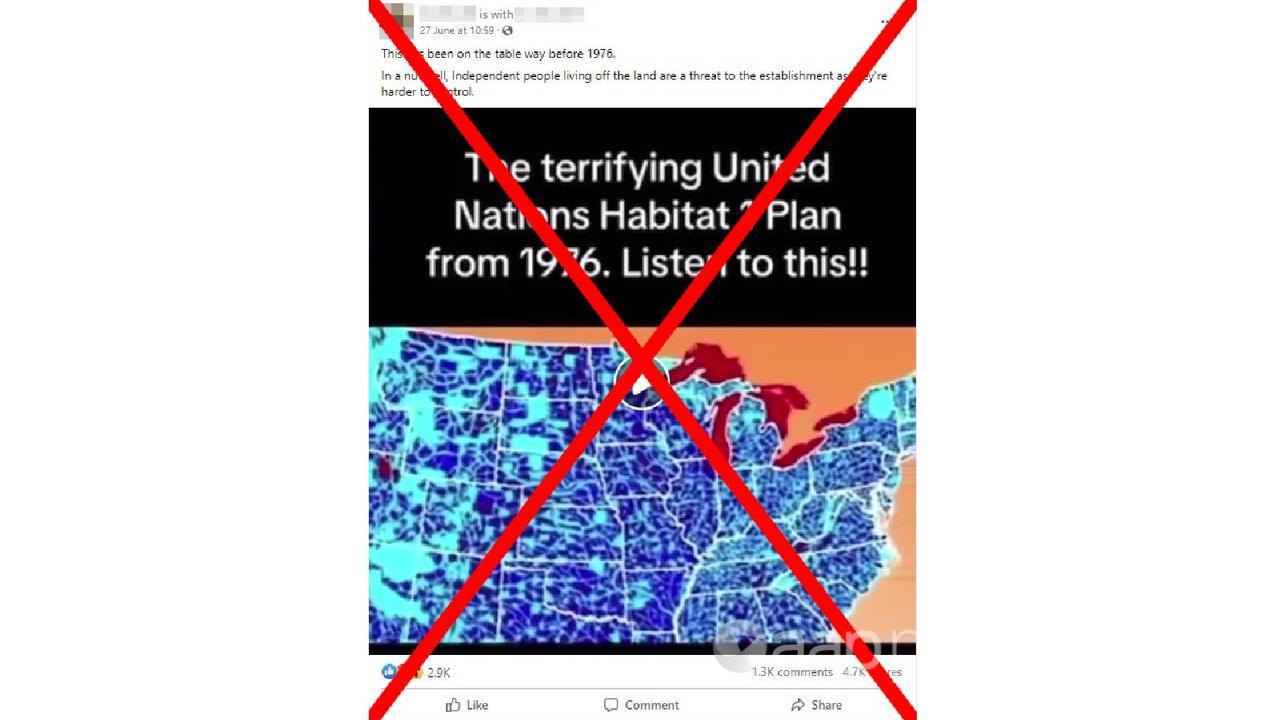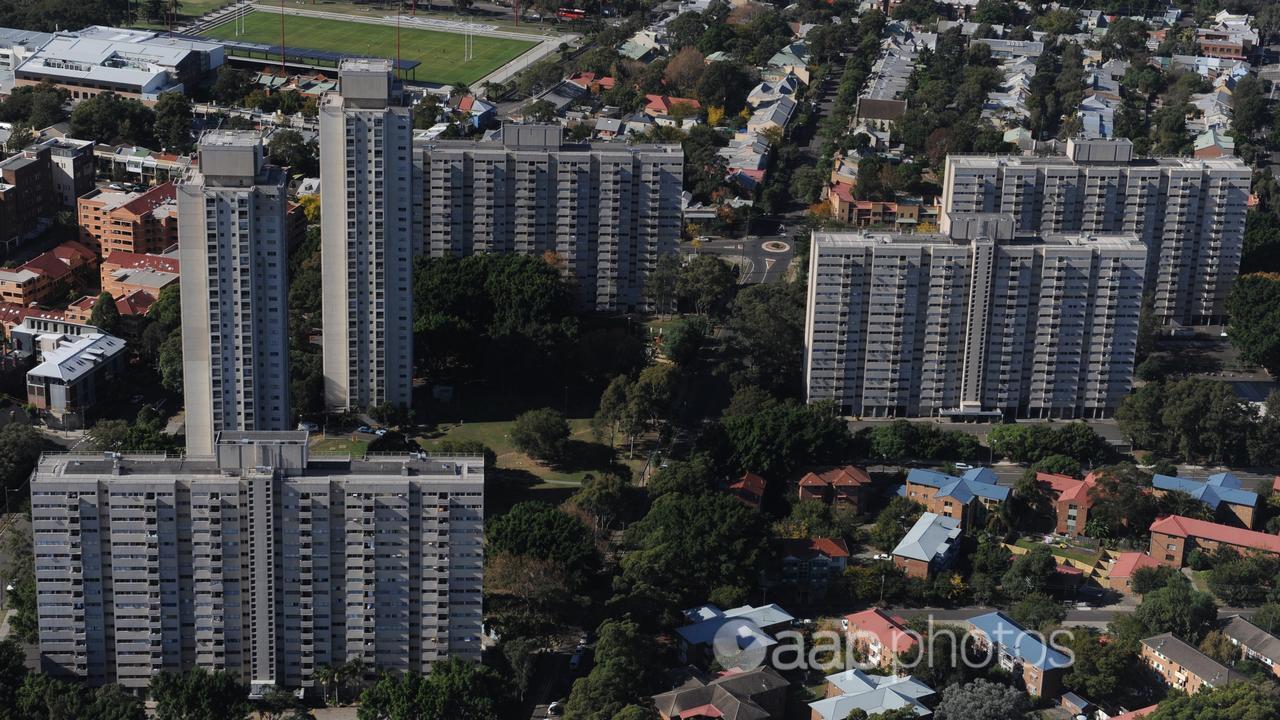A video claims the UN launched plans to force people to relocate to apartments and condominiums in “mega-cities” back in 1976.
This is false. A UN conference nearly 50 years ago, held in response to health and poverty problems arising from increased migration to cities, proposed adequate shelter as a “basic human right”.
The video clip shared on Facebook (screenshot here) features a banner, “The terrifying United Nations Habitat 1 Plan from 1976,” and claims that humans living in rural environments “will be relocated to cities” and that single-family homes will be phased out.

“We the people will live in apartments and condos in mega-cities” built to UN-specified building codes, the video narrator claims, adding “we the humans will live in transit villages and smart cities“.
It’s claimed that electricity and water use will be monitored, and under Agenda 21 people will be banned from living in their own homes.
“These people are a threat to the collectivist society,” a speaker in the video claims.
“That’s the secret behind Agenda 21. They want people out of the country.”
The New Zealand user sharing the video includes a caption saying: “Independent people living off the land are a threat to the establishment as they’re harder to control.”
The video is a clip from a much longer 2020 conspiracy theory film called Unsustainable: The UN’s Agenda for World Domination (video mark 1hr and 29min).

Multiple experts say the claims about forcing people into cities are false and unconnected.
Dr Kiran Shinde, a planning expert at La Trobe University in Melbourne, said the claims in the video were incorrect and unconnected.
“It’s a mishmash and hash of a number of edited clips that do not speak to each other,” he told AAP FactCheck in a phone interview.
“From a narrative point of view there is nothing there. It’s trying to connect too many different ideas in one thread and that’s not true.”
Associate Professor Marco Amati, an international planning expert at RMIT University in Melbourne, said there’s no widescale plan to house people in high-density environments.
“The video presents a grab bag of activities that a viewer might cursorily notice in the urban environment, and attempts to string these together in a conspiracy narrative,” he told AAP FactCheck.

The UN Habitat I conference was held in response to problems caused by rapid urban-rural migration.
Rafael Tuts, the director of the UN-Habitat Global Solutions Division created as a result of the 1976 conference, was perplexed by the video.
“There’s nothing like that,” Mr Tuts told AAP FactCheck in a phone interview.
He said the Habitat I conference in Vancouver, Canada was held in response to the “need for sustainable human settlements and the consequences of rapid urbanisation”.
“Member states of the United Nations saw that the rather rapid increase of urbanisation, especially in developing countries, was creating issues of informal settlements, lack of infrastructure, and kind of an urbanisation and an urban development that was unguided,” Mr Tuts said.
The official UN report on the conference doesn’t mention forced relocations. Instead, the delegates put forward 64 recommendations, “suggesting concrete ways in which people might be assured the basic requirements of human habitation”.
Dr Shinde called the 1976 gathering “a milestone in the way we look at settlements now” and said the video misinterprets its goals and impact.
“There’s nothing in the document that ever said that we need to urbanise,” he explained.

There is no overarching global plan to make people move to cities.
Contrary to claims by conspiracy theorists, Mr Tuts added that the UN doesn’t have the power to order countries to do anything.
“These are not legally binding conventions,” he said, emphasising the plan was “voluntary”.
Dr Shinde agreed the UN doesn’t have any binding powers or powers to implement plans.
“And they make this very clear in every resolution that they pass. Every UN document clearly says that it’s a responsibility of the state to implement these ideas or whatever they want to do with it,” he said. See an example here (points 2, 5 and 8, page 3).
The Facebook video also claims the 1976 conference is linked with UN’s Agenda 21, a 1992 sustainable development plan, and smart cities.
“Each of these ideas (smart growth, smart cities etc.) are in fact quite distinct and have their own narratives and historical development,” Dr Amati said.
“There is no coherence between them and certainly no conspiracy to use them in a coherent way.”
AAP FactCheck has previously debunked various misleading “new world order” themed claims about Agenda 21 here and here and smart cities here and here.
The Verdict
The claim that a 1976 UN conference set goals to force people to move into city apartments from rural environments is false.
Experts told AAP FactCheck that the UN Habitat I conference discussed guidelines to address problems caused by increased migration to cities, particularly in urban areas.
They also noted that the UN has no power to order countries to control their citizens, and any guidelines are voluntary and not legally binding.
False – The claim is inaccurate.
* AAP FactCheck is an accredited member of the International Fact-Checking Network. To keep up with our latest fact checks, follow us on Facebook, Twitter and Instagram.
All information, text and images included on the AAP Websites is for personal use only and may not be re-written, copied, re-sold or re-distributed, framed, linked, shared onto social media or otherwise used whether for compensation of any kind or not, unless you have the prior written permission of AAP. For more information, please refer to our standard terms and conditions.


















